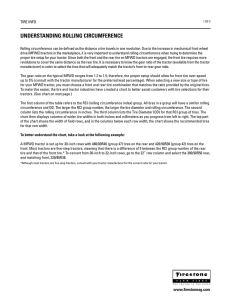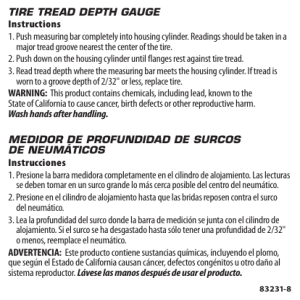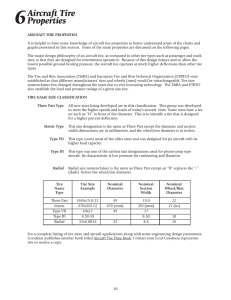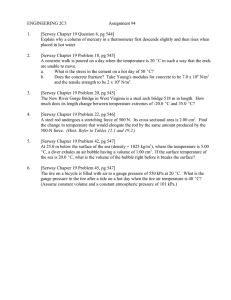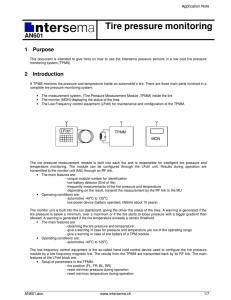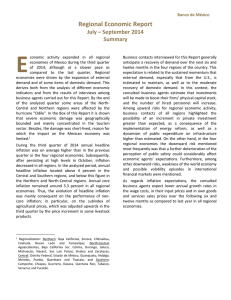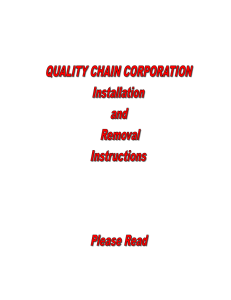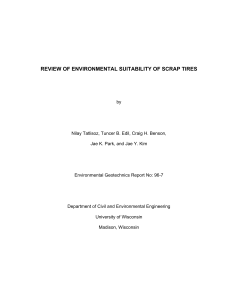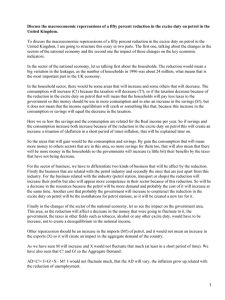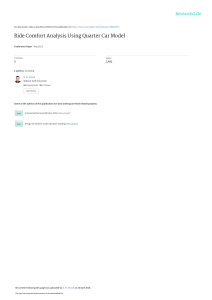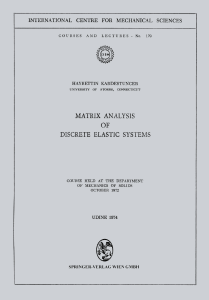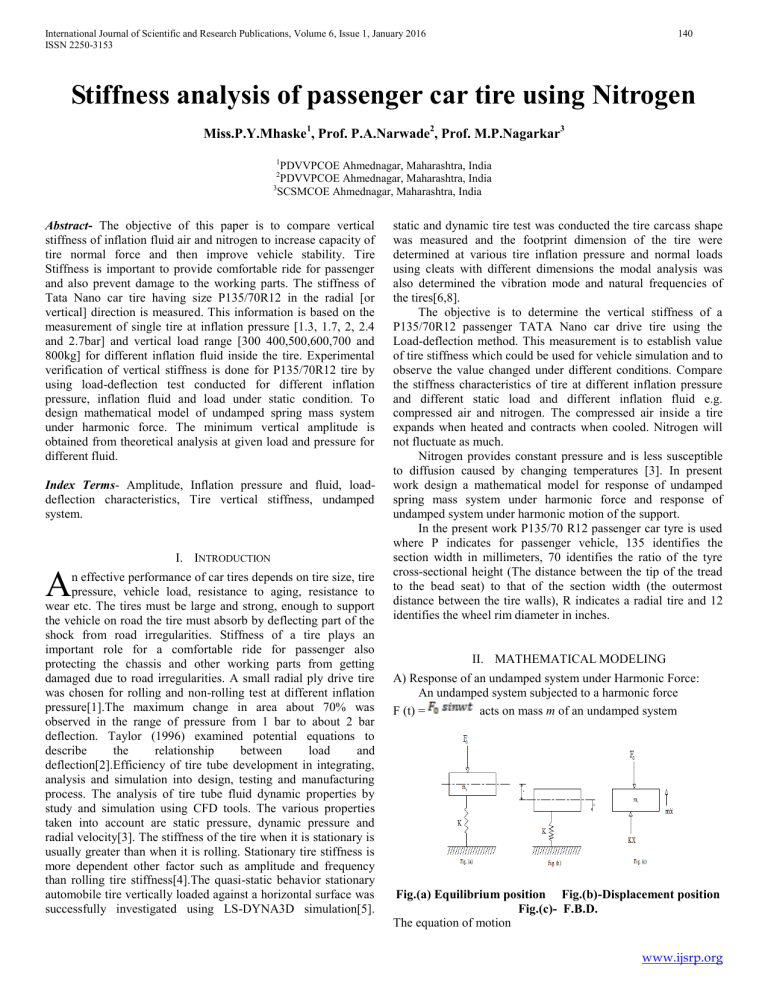
International Journal of Scientific and Research Publications, Volume 6, Issue 1, January 2016 ISSN 2250-3153 140 Stiffness analysis of passenger car tire using Nitrogen Miss.P.Y.Mhaske1, Prof. P.A.Narwade2, Prof. M.P.Nagarkar3 1 PDVVPCOE Ahmednagar, Maharashtra, India PDVVPCOE Ahmednagar, Maharashtra, India 3 SCSMCOE Ahmednagar, Maharashtra, India 2 Abstract- The objective of this paper is to compare vertical stiffness of inflation fluid air and nitrogen to increase capacity of tire normal force and then improve vehicle stability. Tire Stiffness is important to provide comfortable ride for passenger and also prevent damage to the working parts. The stiffness of Tata Nano car tire having size P135/70R12 in the radial [or vertical] direction is measured. This information is based on the measurement of single tire at inflation pressure [1.3, 1.7, 2, 2.4 and 2.7bar] and vertical load range [300 400,500,600,700 and 800kg] for different inflation fluid inside the tire. Experimental verification of vertical stiffness is done for P135/70R12 tire by using load-deflection test conducted for different inflation pressure, inflation fluid and load under static condition. To design mathematical model of undamped spring mass system under harmonic force. The minimum vertical amplitude is obtained from theoretical analysis at given load and pressure for different fluid. Index Terms- Amplitude, Inflation pressure and fluid, loaddeflection characteristics, Tire vertical stiffness, undamped system. I. INTRODUCTION A n effective performance of car tires depends on tire size, tire pressure, vehicle load, resistance to aging, resistance to wear etc. The tires must be large and strong, enough to support the vehicle on road the tire must absorb by deflecting part of the shock from road irregularities. Stiffness of a tire plays an important role for a comfortable ride for passenger also protecting the chassis and other working parts from getting damaged due to road irregularities. A small radial ply drive tire was chosen for rolling and non-rolling test at different inflation pressure[1].The maximum change in area about 70% was observed in the range of pressure from 1 bar to about 2 bar deflection. Taylor (1996) examined potential equations to describe the relationship between load and deflection[2].Efficiency of tire tube development in integrating, analysis and simulation into design, testing and manufacturing process. The analysis of tire tube fluid dynamic properties by study and simulation using CFD tools. The various properties taken into account are static pressure, dynamic pressure and radial velocity[3]. The stiffness of the tire when it is stationary is usually greater than when it is rolling. Stationary tire stiffness is more dependent other factor such as amplitude and frequency than rolling tire stiffness[4].The quasi-static behavior stationary automobile tire vertically loaded against a horizontal surface was successfully investigated using LS-DYNA3D simulation[5]. static and dynamic tire test was conducted the tire carcass shape was measured and the footprint dimension of the tire were determined at various tire inflation pressure and normal loads using cleats with different dimensions the modal analysis was also determined the vibration mode and natural frequencies of the tires[6,8]. The objective is to determine the vertical stiffness of a P135/70R12 passenger TATA Nano car drive tire using the Load-deflection method. This measurement is to establish value of tire stiffness which could be used for vehicle simulation and to observe the value changed under different conditions. Compare the stiffness characteristics of tire at different inflation pressure and different static load and different inflation fluid e.g. compressed air and nitrogen. The compressed air inside a tire expands when heated and contracts when cooled. Nitrogen will not fluctuate as much. Nitrogen provides constant pressure and is less susceptible to diffusion caused by changing temperatures [3]. In present work design a mathematical model for response of undamped spring mass system under harmonic force and response of undamped system under harmonic motion of the support. In the present work P135/70 R12 passenger car tyre is used where P indicates for passenger vehicle, 135 identifies the section width in millimeters, 70 identifies the ratio of the tyre cross-sectional height (The distance between the tip of the tread to the bead seat) to that of the section width (the outermost distance between the tire walls), R indicates a radial tire and 12 identifies the wheel rim diameter in inches. II. MATHEMATICAL MODELING A) Response of an undamped system under Harmonic Force: An undamped system subjected to a harmonic force F (t) = acts on mass m of an undamped system Fig.(a) Equilibrium position Fig.(b)-Displacement position Fig.(c)- F.B.D. The equation of motion www.ijsrp.org International Journal of Scientific and Research Publications, Volume 6, Issue 1, January 2016 ISSN 2250-3153 For Steady State Amplitude (X) (1) The solution of equation xc= c1cosn t + c2 sinn t xp = Xsint 141 (8) (2) (3) X = Steady state Amplitude Y = Amplitude of Sine curve (m) X= Maximum Amplitude of xp III. EXPERIMENTAL ANALYSIS A small passenger Nano car tire P135/70R12 was selected for this study, a pivoting test frame was constructed with a length L of 1235mm from the pivot to the Axle center. For vertical deflection test consisted of a mild steel base plate with an inverted u-shaped bracket to support the axle. The distance from the base plate to the tabs was 450mm, which placed the axle center 470mm from the base plate. (4) The Total solution of equation (1) becomes, X(t)=c1cosn t + c2 sinn t + * sint Using initial condition, X(t=0)=x0 and (t=0) = 2x (t) =[ x- ] ) + sint (5) This equation (5) obtained complete solution superposition of transient and steady state vibration. by B) Response of an undamped system under Harmonic motion of the Support: The tire is modeled as a linear spring without damping. The support is excited by a sinusoidal motion y=Y sint Fig.1 Experimental Setup 1. Hydraulic jack, 2.vernire height gauge, 3.Tested tire, 5.hydraulic pump, 6.pressure gauge 4, 7 supporting frame Fig.(a)- Equilibrium position Fig.(b)- Displacement position Fig.(c)- F.B.D. x=Displacement of mass ‘m’ from its equilibrium position y= Displacement of support y =Y sint The differential equation of motion is Vertical load applied by using hydraulic jack at different inflation pressure. A vernire height gauge having least count 0.02mm was used to measure vertical displacement from the axle. Test is conducted at five pressure (1.3, 1.7, 2, 2.4 and 2.7bar) by increasing the static load and measuring static loaded radius (SLR) as the tire rested on a smooth metal The vertical load (300,400,500,600,700 and 800kg) applied on the test frame for fluid Air and Nitrogen. (6) IV. RESULT ANALYSIS (7) The experimental results are obtained by varying stiffness parameters as follows The equation (xi) is known as Differential equation of motion an undamped system which is similar to a linear second order differential equation of motion www.ijsrp.org International Journal of Scientific and Research Publications, Volume 6, Issue 1, January 2016 ISSN 2250-3153 142 A) Effect of change in inflation fluid Air Tire Deflection [mm] 1.3 1.7 2 2.4 2.7 bar bar bar bar bar 300 17.8 15.7 14.8 14 12.72 400 24.6 21.9 20.10 20 18.34 500 31.7 28.44 27.6 26 24.02 600 38.5 34.4 31.09 30.50 28.84 700 44.4 39.7 36.04 34.90 33.7 800 49 42.30 40.05 38.30 37.10 Table1. Effect of change in inflation fluid (Air) Load [kg] Graph 1.Combined effect of tire deflection versus load for Air Graph shows at constant pressure, when load is increasing then tire deflection increases linearly. Pressure 1.3bar shows more deflection at all load values. Tire deflection gradually decreases when increasing tire pressure at any constant load value. B) Effect of change in inflation fluid Nitrogen Tire Deflection [mm] 1.3 1.7 2 2.4 2.7 bar bar bar bar bar 300 16.7 15.02 14.2 13.35 11.9 400 23.6 20.4 19.32 19 17.5 500 30.4 27.6 26.2 25.12 23.20 600 36 33.3 30.5 29.08 27.54 700 41.7 38.5 35.24 34.8 32.82 800 46.10 41 39.08 37.40 36.4 Table 2. Effect of change in inflation fluid (Nitrogen) Load [kg] Graph 2.Combined effect of tire deflection versus load for Nitrogen www.ijsrp.org International Journal of Scientific and Research Publications, Volume 6, Issue 1, January 2016 ISSN 2250-3153 143 Graph shows at constant pressure, when load is increasing then tire deflection increases linearly. Pressure 1.3bar shows more deflection at all load values. C) Effect of inflation pressure on Stiffness for Air: Tire Stiffness value determined at different inflation pressure is the ratio of applied load on the tire to the deflection. Inflation pressure of tire increases then stiffness of tire is increases. Shows stiffness values at different pressures at inflation fluid as Air Pressure 1.3bar Pressure 1.7 bar Def. Stiffness Load Def. Stiffness mm N/mm kg mm N/mm 17.8 165.33 300 15.7 187.45 24.6 159.51 400 21.9 179.17 31.7 154.73 500 28.44 172.46 38.5 152.88 600 34.4 171.10 44.4 154.66 700 39.7 172.97 49 160.16 800 42.3 185.53 Pressure 2 bar Pressure 2.4bar Load Def. Stiffness Load Def. Stiffness kg mm N/mm kg mm N/mm 300 14.8 198.85 300 14 210.21 400 20.1 195.22 400 20 196.2 500 27.6 177.71 500 26 188.65 600 31.09 189.32 600 30.5 192.98 700 36.04 190.53 700 34.9 196.76 800 40.05 195.95 800 38.3 204.90 Pressure 2.7bar Load Def. Stiffness kg mm N/mm 300 12.72 231.36 400 18.34 213.95 500 24.02 204.20 600 28.84 204.09 700 33.7 203.76 800 37.1 211.53 Table 3. Effect of inflation pressure on Stiffness for Air Load kg 300 400 500 600 700 800 Graph shows the combined effect of all load values on Tire stiffness when inflation fluid as Air in tire Graph 3. Tire stiffness versus load for Air At constant load Inflation pressure increases then tire stiffness is also increases. www.ijsrp.org International Journal of Scientific and Research Publications, Volume 6, Issue 1, January 2016 ISSN 2250-3153 144 D) Effect of inflation pressure on stiffness for Nitrogen: Inflation pressure of tire increases then stiffness of tire is increases. Shows stiffness values at different pressures at inflation fluid as Nitrogen Pressure 1.3bar Pressure 1.7bar Def. Stiffness Load Def. Stiffness mm N/mm kg mm N/mm 16.7 176.22 300 15 195.93 23.6 166.27 400 20.4 192.35 30.4 161.34 500 27.6 177.71 36 163.5 600 33.3 176.75 41.7 164.67 700 38.5 178.36 46.1 170.23 800 41 191.41 Pressure 2bar Pressure 2.4 bar Load Def. Stiffness Load Def. Stiffness kg mm N/mm kg mm N/mm 300 14.2 207.25 300 13.3 220.44 400 19.3 203.10 400 19 206.52 500 26.2 187.21 500 25.1 195.26 600 30.5 192.98 600 29 202.40 700 35.2 194.86 700 34.8 197.32 800 39.0 200.81 800 37.4 209.83 Pressure 2.7bar Load Def. Stiffness kg mm N/mm 300 11.9 247.31 400 17.5 224.22 500 23.2 211.42 600 27.5 213.72 700 32.8 209.23 800 36.4 215.60 Table 4. Effect of inflation pressure on Stiffness for Nitrogen Load kg 300 400 500 600 700 800 Graph shows the combined effect of all load values on tire stiffness when inflation fluid as Nitrogen in tire Graph 4. Tire stiffness versus load for Nitrogen At constant load Inflation pressure increases then tire stiffness is also increase. At pressure 2.7bar tire stiffness is more compare to the other pressure values. www.ijsrp.org International Journal of Scientific and Research Publications, Volume 6, Issue 1, January 2016 ISSN 2250-3153 145 E) Theoretical analysis for vertical amplitude of vibration (X): Consider a TATA Nano car moves over a road surface having sinusoidal profile with a wavelength of 4m and amplitude of 0.15m. m= Mass of tire (kg) = 14kg K= Tire stiffness (N/m) λ = wavelength of sine curve (m) = 4m Y= Amplitude of sinusoidal surface (m) =0.15m n = Natural circular frequency of the system (rad/s) = circular frequency of external exciting force (rad/s) V = speed of vehicle (km/hr) = 100km/hr V = (100 * 1000)/3600 = 27.77m/sec Vertical Amplitude of vibration (X): Steady state amplitude due to excitation of support n = (i) (ii) For inflation fluid: Air For inflation fluid: Nitrogen Pressure 1.3bar Pressure 1.3bar Load Wn X Load Wn X (kg) (rad/s) (m) (Kg) (rad/s) (m) 300 108.67 0.1788 300 112.19 0.1767 400 106.74 0.1800 400 108.97 0.1786 500 105.12 0.1812 500 107.35 0.1796 600 104.49 0.1816 600 108 0.1792 700 105.10 0.1812 700 106.4 0.1803 800 106.95 0.1799 800 110.26 0.1778 Table.5.Vertical amplitude of vibration for pressure 1.3bar Graph 5.comparison of amplitude of Air and Nitrogen at pressure 1.3bar www.ijsrp.org International Journal of Scientific and Research Publications, Volume 6, Issue 1, January 2016 ISSN 2250-3153 For inflation fluid: Air Pressure 1.7bar 146 For inflation fluid: Nitrogen Pressure 1.7bar Load Wn X (Kg) (rad/s) (m) 300 118.3 0.1736 400 117.2 0.1741 500 112.66 0.1764 600 112.36 0.1766 700 112.87 0.1763 800 116.92 0.1742 Load Wn X (kg) (rad/s) (m) 300 115.71 0.1748 400 113.13 0.1762 500 110.99 0.1774 600 110.55 0.1776 700 111.15 0.1773 800 115.11 0.1751 Table 6.Vertical amplitude of vibration for pressure 1.7bar Graph 6.comparison of amplitude of Air and Nitrogen at pressure 1.7bar For Inflation Fluid: Air Pressure 2bar For inflation fluid: Nitrogen Pressure 2bar Load Wn X (Kg) (rad/s) (m) 300 121.67 0.1721 400 120.44 0.1726 500 115.63 0.1748 600 117.4 0.1740 700 117.97 0.1737 800 119.8 0.1729 Load Wn X (kg) (rad/s) (m) 300 119.17 0.1732 400 118 0.1737 500 112.66 0.1764 600 116.28 0.1745 700 116.66 0.1743 800 118 0.1737 Table 7.Vertical amplitude of vibration for pressure 2bar Graph 7.comparison of amplitude of Air and Nitrogen at pressure 2bar www.ijsrp.org International Journal of Scientific and Research Publications, Volume 6, Issue 1, January 2016 ISSN 2250-3153 147 For Inflation Fluid: Air For inflation fluid: Nitrogen Pressure 2.4bar Pressure 2.4bar Load Wn X Load Wn X (kg) (rad/s) (m) (Kg) (rad/s) (m) 300 122.53 0.1717 300 125.48 0.1706 400 118 0.1737 400 121.45 0.1722 500 116 0.1747 500 118.09 0.1737 600 117 0.1742 600 120.23 0.1727 700 118.55 0.1734 700 118.72 0.1734 800 120.17 0.1727 800 122.42 0.1718 Table 8.Vertical amplitude of vibration for pressure 2.4bar Graph 8.comparison of amplitude of Air and Nitrogen at pressure 2.4bar For Inflation Fluid: Air For inflation fluid : Nitrogen Pressure 2.7bar Pressure 2.7bar Load Wn X Load Wn X (kg) (rad/s) (m) (Kg) (rad/s) (m) 300 128.55 0.1695 300 132.9 0.1681 400 123.62 0.1731 400 126.55 0.1702 500 120.77 0.1725 500 122.88 0.1716 600 120.64 0.1725 600 123.55 0.1713 700 120 0.1728 700 122.24 0.1718 800 122 0.1719 800 124.09 0.1711 Table 9.Vertical amplitude of vibration for pressure 2.7bar Graph 9.comparison of amplitude of Air and Nitrogen at pressure 2.7bar www.ijsrp.org International Journal of Scientific and Research Publications, Volume 6, Issue 1, January 2016 ISSN 2250-3153 V. CONCLUSION Vertical Radial stiffness of passenger car tire P135/70R12 is successfully investigated using load deflection method under a static condition by using experimental test frame setup. Tire deflection for fluid Nitrogen is less compare to Air for all pressures. The Inflation pressure directly influences the stiffness of the tire as inflation pressure increase, the stiffness of the tire also increases. From theoretical analysis the minimum vertical amplitude is obtained at given load and pressure condition for a fluid Nitrogen compare to Air. This indicates that minimum bump in the road is transmitted to the chassis and the passenger of the car [4] [5] [6] [7] [8] 148 Of Emergimg Technology And Advanced Engineering, ISSN 2250-2459, ISO 9001:2008 Volume 3, issue 10, October 2013. J.A.Lines, K.Murphy, ‘ The Stiffness Of Agricultural Tractor Tires’ Science Direct Journal Of Terramechanics, vol.28, No.1,1991 pp-49-64 W.Hall, R.P.Jones,J. T.Mottram, ‘Modeling Of An Automobile Tires Using LS-DYNA 3D’, School Of Engineering,University Of Warwick,Coventry,CV4 7AL, UK M.JoachimStallmann, P.SchalkEls, Carl M. Bekker, ‘ Parameterization And Modeling Of Large Off-Road Tires For Ride Analysis: Part-I Obtaining ParamerterizationData’science Direct Journal Of Terramechanics, vol.55 (2014) 73-84. MaciejBerdychowski, Konrad J. Walus, ‘ Verification Of Simulation Model With Actual Research Vertical Stiffness Passenger Car Tire’, Machine Dynamics Research Vol.37 No.2, 5-14,2013, YanhaiXu, Mehdi Ahmadian, ‘Improving The Capacity Of Tire Normal Force Via Variable Stiffness And Damping Suspension System’, Sciverse Science Direct Journal Of Terramechanics 50 (2013) 121-132 REFERENCES [1] [2] [3] K.Kulikowaski , D Szpica, ‘Determination Of Directional Stiffness Of Vehicle Tires Under A Static Load Operation’, Maintenance And Reliability, Vol.16, No.1,2014 R.K.Taylor,L.L.Bashford,M.D.Schrock ,’Methods For Measuring Vertical Tire Stiffness’, American Society Of Agricultural Engineers 00012351,Vol.43(6),2001. S.Devaraj,T.Ramprasath, S.John David, ‘A Study On Fluide Dynamic Properties Of A Passenger Tire Tube By Using CFD’, International Journal AUTHORS First Author – Miss.P.Y.Mhaske, PDVVPCOE Ahmednagar, Maharashtra, India Second Author– Prof. P.A.Narwade, PDVVPCOE Ahmednagar, Maharashtra, India Third Author– Prof. M.P.Nagarkar, SCSM COE Ahmednagar, Maharashtra, India www.ijsrp.org
